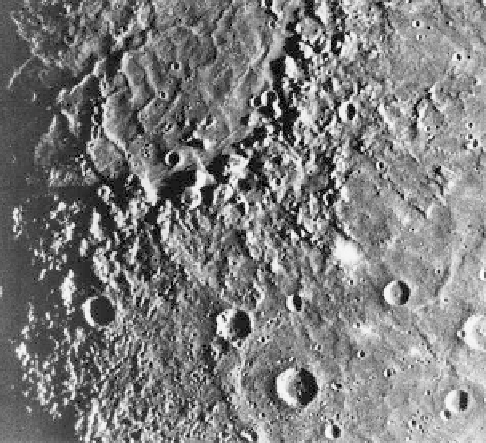Geology Reference
In-Depth Information
Figure 5.23. A view of the northeast side of the Caloris basin,
showing the radial lineated terrain of the Van Eyck Formation, one
of the ejecta facies of Caloris; the area shown is about 590 km across
(NASA Mariner 10 FDS 193).
Figure 5.22. A Mariner 10 view of the Caloris Montes, the main
ring of the basin; area shown is about 730 km across (NASA
Mariner 10 FDS 229).
The interior of the Caloris basin is
floored with plains
materials that commonly have ridges, troughs, and frac-
tures (
Fig. 5.24
), similar in morphology to the smooth
plains found elsewhere on Mercury. Unlike lunar mare
deposits inside basins on the Moon, the Caloris plains are
high in albedo and appear to lack iron oxide. The ridges
are 50
-
300 km long and 1
-
12 km wide, by 100
-
500 m
high, and form roughly polygonal patterns. Many of the
troughs have
at
floors, suggestive of grabens, and tend to
be either concentric with the Caloris rim or radial to the
center of the basin. The origin of the basin
floor plains is
somewhat controversial, although most workers agree that
the material is not associated with the Caloris impact
because the plains are much younger, as indicated by
low superposed impact crater frequencies. It is likely
that the plains represent
flooding by volcanic materials
that deformed upon cooling to form the ridges and
fractures.
Figure 5.25
shows Pantheon Fossae, informally termed
Figure 5.24. Smooth plains
floor of the Caloris basin (left half
of image) and embay the Caloris Montes (right side). The plains show
ridges, troughs, and fractures re
ecting deformation of the inferred
volcanic deposits; the area shown is 275 km across (NASA Mariner 10
FDS 110).
fill the
“
because of the radial pattern of troughs (i.e.,
fossae). Superposed on Pantheon Fossae is the 40 km in
diameter impact crater Apollodorus, indicating that the
fossae pre-date the impact. The troughs are considered to
be grabens and about 230 have been mapped that con-
verge near the center of the basin, suggesting that exten-
sion of the basin-
ll took place, perhaps as a consequence
of magma intrusion.
Analysis of images fromMariner 10 led to the discovery
of an unusual terrain in the region antipodal (on the
the Spider,
”
textured terrain to the northeast of the basin marks the Van
Eyck Formation (
Fig. 5.23
), while hummocky and dark
knobby terrain to the east comprises the Odin Formation;
both units are considered to be facies of the Caloris ejecta
deposits. MESSENGER data show that the rim deposits,
intermontane materials, and ejecta facies all have the same
spectral properties, suggesting that they have the same
composition.





